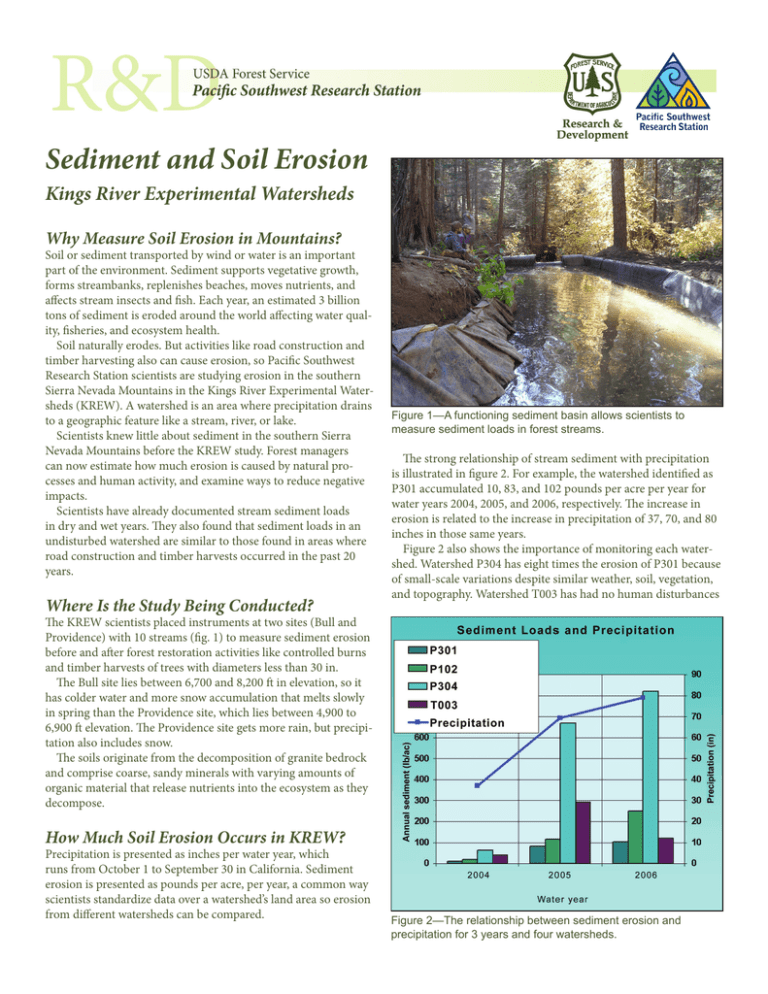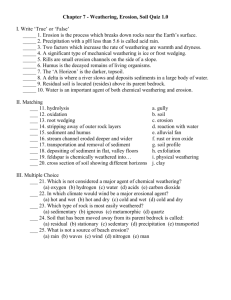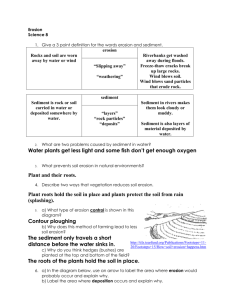Sediment and Soil Erosion Kings River Experimental Watersheds
advertisement

Sediment and Soil Erosion Kings River Experimental Watersheds Why Measure Soil Erosion in Mountains? Soil or sediment transported by wind or water is an important part of the environment. Sediment supports vegetative growth, forms streambanks, replenishes beaches, moves nutrients, and affects stream insects and fish. Each year, an estimated 3 billion tons of sediment is eroded around the world affecting water quality, fisheries, and ecosystem health. Soil naturally erodes. But activities like road construction and timber harvesting also can cause erosion, so Pacific Southwest Research Station scientists are studying erosion in the southern Sierra Nevada Mountains in the Kings River Experimental Watersheds (KREW). A watershed is an area where precipitation drains to a geographic feature like a stream, river, or lake. Scientists knew little about sediment in the southern Sierra Nevada Mountains before the KREW study. Forest managers can now estimate how much erosion is caused by natural processes and human activity, and examine ways to reduce negative impacts. Scientists have already documented stream sediment loads in dry and wet years. They also found that sediment loads in an undisturbed watershed are similar to those found in areas where road construction and timber harvests occurred in the past 20 years. Where Is the Study Being Conducted? Figure 1—A functioning sediment basin allows scientists to measure sediment loads in forest streams. The strong relationship of stream sediment with precipitation is illustrated in figure 2. For example, the watershed identified as P301 accumulated 10, 83, and 102 pounds per acre per year for water years 2004, 2005, and 2006, respectively. The increase in erosion is related to the increase in precipitation of 37, 70, and 80 inches in those same years. Figure 2 also shows the importance of monitoring each watershed. Watershed P304 has eight times the erosion of P301 because of small-scale variations despite similar weather, soil, vegetation, and topography. Watershed T003 has had no human disturbances The KREW scientists placed instruments at two sites (Bull and Providence) with 10 streams (fig. 1) to measure sediment erosion before and after forest restoration activities like controlled burns and timber harvests of trees with diameters less than 30 in. The Bull site lies between 6,700 and 8,200 ft in elevation, so it has colder water and more snow accumulation that melts slowly in spring than the Providence site, which lies between 4,900 to 6,900 ft elevation. The Providence site gets more rain, but precipitation also includes snow. The soils originate from the decomposition of granite bedrock and comprise coarse, sandy minerals with varying amounts of organic material that release nutrients into the ecosystem as they decompose. How Much Soil Erosion Occurs in KREW? Precipitation is presented as inches per water year, which runs from October 1 to September 30 in California. Sediment erosion is presented as pounds per acre, per year, a common way scientists standardize data over a watershed’s land area so erosion from different watersheds can be compared. Figure 2—The relationship between sediment erosion and precipitation for 3 years and four watersheds. like road construction or timber harvests, yet has erosion similar to that found in watersheds P301 and D102 where these types of activities occurred. What Factors Affect Soil Erosion? Soil is transported by wind, water, and gravity. Local weather patterns, topography, vegetation, and soil type are the most important factors affecting erosion. Precipitation and stream discharge transport soil down steep hills and channels within KREW watersheds. Scientists found yearly precipitation ranged from 35 to 80 in during 5 years, with 99 percent falling between October and May. Soil stability following land management activity is dependent upon the intensity, length, and type of precipitation received. Vegetation will not rapidly reestablish its elf if watersheds receive little rainfall. But soil might not move far when precipitation is low. Conversely, vegetation grows rapidly in wet years; however, intense storms can erode and deposit soil even where there is some vegetative cover. Scientists expect that watersheds experiencing controlled burns and timber harvests will have increased erosion immediately following those activities. Erosion rates would likely decrease each year and eventually return to rates like those before such activities occurred. The KREW study will further determine the change and variability in erosion for the southern Sierra Nevada Mountains before and after management activities like controlled burning and timber harvests. How Is Soil Erosion Measured? The KREW study team has constructed basins at the outlet of each watershed to capture sediment moving downstream. The basins range from 15 to 25 ft wide by 30 to 50 ft long (fig. 1), and are constructed from wooden frames lined with thick rubber. The entire stream flows into a basin, creating a large pool where water slows down. Here suspended sediment settles, and larger sediment, or bedload, stops moving along the bottom of the stream. Water resumes its natural flow when it leaves the basin outlet. Scientists remove all sediment from the basin at the end of each year to determine the amount of mineral and vegetative material. The KREW study team calculates the annual amount of erosion by measuring field and lab data and volume of water flowing through each stream. Additional measurements will determine the amount of sediment that comes from each source–roads, road crossings at streams, streambanks, and hillsides. Can We Predict Soil Erosion? Computer models can predict the amount of erosion that might occur under various weather and forest management conditions. One such model is called the Water Erosion Prediction Project (WEPP). With WEPP, the user can estimate erosion by varying inputs for weather, topography, soil type, vegetation, rock content, and management activities. Figure 3 illustrates the three situations that might occur following tree thinning, timber harvests, and controlled burns in a watershed similar to KREW. Figure 3—Water erosion prediction project (WEPP) predicted sediment yield for Kings River Experimental Watersheds (KREW) following treatments. Model inputs were varied to estimate the impact of different weather conditions after a treatment. The model also considered the impacts of a 50-ft-wide riparian buffer, or strip of untreated land on both sides of a stream, that minimizes impacts. As expected, WEPP predicts a spike in erosion in the first years following treatments. Soil stability increases as new forest floor debris such as twigs, leaves, and needles accumulate and vegetation returns. The model predicts that in 5 to 20 years, watershed soil erosion rates will return to erosion rates found before forest management activities occurred. As figure 3 shows, in a typical KREW climate, the least amount of erosion occurs if managers establish a riparian buffer. Without buffers, erosion rates are about double immediately following treatments. Increasing precipitation also increases erosion, as shown by the higher line. The top line represents conditions if KREW experienced very high precipitation amounts (30-year maximum) consistently for 20 years following treatment, even with a buffer. The KREW has a unique opportunity to compare actual soil erosion rates with those predicted by computer models because scientists installed basins on each experimental stream. For existing pretreatment conditions, WEPP is estimating lower erosion (fig. 3) than scientists actually measured in the basins of some watersheds (fig. 2). This information can be used to improve the use of WEPP for land managers in the Sierra Nevada Mountains and reduce negative impacts on streams from future land management activities. For more information contact: Dr. Carolyn Hunsaker, chunsaker@fs.fed.us, (559) 323-3211 www.fs.fed.us/psw/programs/snrc/water/kingsriver September 2009







